The AMD Llano Notebook Review: Competing in the Mobile Market
by Jarred Walton & Anand Lal Shimpi on June 14, 2011 12:01 AM ESTThe Llano A-Series APU
Although Llano is targeted solely at the mainstream, it is home to a number of firsts for AMD. This is AMD's first chip built on a 32nm SOI process at GlobalFoundries, it is AMD's first microprocessor to feature more than a billion transistors, and as you'll soon see it's the first platform with integrated graphics that's actually worth a damn.
AMD is building two distinct versions of Llano, although only one will be available at launch. There's the quad-core, or big Llano, with four 32nm CPU cores and a 400 core GPU. This chip weighs in at 1.45 billion transistors, nearly 50% more than Sandy Bridge. Around half of the chip is dedicated to the GPU however, so those are tightly packed transistors resulting in a die size that's only 5% larger than Sandy Bridge.
| CPU Specification Comparison | ||||||||
| CPU | Manufacturing Process | Cores | Transistor Count | Die Size | ||||
| AMD Llano 4C | 32nm | 4 | 1.45B | 228mm2 | ||||
| AMD Llano 2C | 32nm | 2 | 758M | ? | ||||
| AMD Thuban 6C | 45nm | 6 | 904M | 346mm2 | ||||
| AMD Deneb 4C | 45nm | 4 | 758M | 258mm2 | ||||
| Intel Gulftown 6C | 32nm | 6 | 1.17B | 240mm2 | ||||
| Intel Nehalem/Bloomfield 4C | 45nm | 4 | 731M | 263mm2 | ||||
| Intel Sandy Bridge 4C | 32nm | 4 | 995M | 216mm2 | ||||
| Intel Lynnfield 4C | 45nm | 4 | 774M | 296mm2 | ||||
| Intel Clarkdale 2C | 32nm | 2 | 384M | 81mm2 | ||||
| Intel Sandy Bridge 2C (GT1) | 32nm | 2 | 504M | 131mm2 | ||||
| Intel Sandy Bridge 2C (GT2) | 32nm | 2 | 624M | 149mm2 | ||||
Given the transistor count, big Llano has a deceptively small amount of cache for the CPU cores. There is no large catch-all L3 and definitely no shared SRAM between the CPU and GPU, just a 1MB private L2 cache per core. That's more L2 cache than either the 45nm quad-core Athlon II or Phenom II parts.

Intel's Sandy Bridge die is only ~20% GPU
The little Llano is a 758 million transistor dual-core version with only 240 GPU cores. Cache sizes are unchanged; little Llano is just a smaller version for lower price points. Initially both quad- and dual-core parts will be serviced by the same 1.45B transistor die. Defective chips will have unused cores fused off and will be sold as dual-core parts. This isn't anything unusual, AMD, Intel and NVIDIA all use die harvesting as part of their overall silicon strategy. The key here is that in the coming months AMD will eventually introduce a dedicated little Llano die to avoid wasting fully functional big Llano parts on the dual-core market. This distinction is important as it indicates that AMD isn't relying on die harvesting in the long run but rather has a targeted strategy for separate market segments.
Architecturally AMD has made some minor updates to each Llano core. AMD is promising more than a 6% increase in instructions executed per clock (IPC) for the Llano cores vs. their 45nm Athlon II/Phenom II predecessors. The increase in IPC is due to the larger L2 cache, larger reorder and load/store buffers, new divide hardware, and improved hardware prefetchers.
On average I measured around a 3% performance improvement at the same clock speed as AMD's 45nm parts. Peak performance improved up to 14% however most of the gains were down in the 3—5% range. This is arguably the biggest problem that faces Llano. AMD's Phenom architecture debuted in 2007 and was updated in 2009. Llanos cores have been sitting around for the past 3-4 years with only a mild update while Intel has been through two tocks in the same timeframe. A ~6% increase in IPC isn't anywhere near close enough to bridge the gap left by Nehalem and Sandy Bridge.
Note that this comparison is without AMD's Turbo Core enabled, but more on that later.












177 Comments
View All Comments
JarredWalton - Tuesday, June 14, 2011 - link
Civ5 and TWS2 are both tested with the latest drivers. The K53E was also tested with drivers that are at most a couple months old. Intel current lists the latest laptop drivers as 15.22.1.64.2361 from 4/13/2011, which is what I'm running on the Intel units right now. If there are some newer drivers that I'm missing out on, let me know and I'll go try them.duploxxx - Tuesday, June 14, 2011 - link
Nice review, it seems like there is a lot of work on CF.Actually I reviewed the Liano already months ago, I mentioned in the last mobile reviews that it will be better performing then the Toshiba with the P920 with really good battery performance. So it is a win -win for the budget line anyhow. Top line remains intel for the CPU power.
Regarding the quote:
Now if you want to have your cake and eat it too, the APU to wait for would be Trinity. Due out somewhere in the 2012 - 2013 timeframe, combine a Bulldozer derived architecture with AMD's next-generation GPU architecture and you've got Trinity.
Trinity will not only be an improved GPU it also has the BD core inthere which will offer much more punch. THe reason LIano is late is because of the 32NM process. It could have been released much sooner. Sure they took an outdated K10 and that is the main issue together with the not enough aggressive Turbo for single thread, they should have adapted this more aka BD.
But assumin Trinity is a rather late 2012 project (by stating 2012-2013) you are way way off...
ET - Tuesday, June 14, 2011 - link
Quote probably reflects an increase in pessimism due to recent events. Bulldozer is still not out, and AMD is said to have had a hard time getting clocks up. So sure, we're all hoping to see Trinity early in 2012, but anyone setting their expectations a little farther are less likely to be disappointed.duploxxx - Wednesday, June 15, 2011 - link
didn't i mentioned it would be launch faster then expected?http://www.cpuforever.com/showthread.php?tid=1574&...
the delay of Zambezi BD has nothing to do with real architecture issues.....
ET - Wednesday, June 15, 2011 - link
That's not the sites which posted on it, including Anandtech, said based on what AMD said (that is, that Bulldozer was not up to speed).Jamahl - Tuesday, June 14, 2011 - link
Was that really needed? I mean...really? Who the hell would do that and for what reason?ET - Tuesday, June 14, 2011 - link
I already got my E-350 laptop, but as Jarred says, Brazos just became less interesting. I'll be waiting to see what price point and performance the dual core Llano will have. What impressed me most was battery life, which is competitive with the E-350 laptop, and it'd be interesting to see how small and light Llano laptops will get.The other takeaway I have from this is that as usual I'm impressed at how far Intel has gone with its integrated graphics. Sure Llano gives it a good beating, but that's at the expense of a lot more die space. I imagine that Intel will continue to tweak its 3D cores and I can't wait to see how this race will develop.
Anosh - Tuesday, June 14, 2011 - link
What happened to power consumption?!Some of us get laptops due to the optimization in the power department over similar desktop parts!
JarredWalton - Tuesday, June 14, 2011 - link
Power = [Battery Capacity] / .98 [efficiency] / ([Battery life in minutes] / 60)So if you take the battery life charts, you can determine roughly what the total system power draw is using the above. Or you can look at the "Relative Battery Life" charts and get the same information as Minutes/Wh instead of converting into Watts.
jabber - Tuesday, June 14, 2011 - link
In my work I get a lot of laptops to fix. If there is one game or genre that appears on 80% or more of them its......The Sims.
I also get asked a lot "if I buy this laptop will it play The Sims?"
Never ever been asked if a laptop will play Crysis or any of the games you use.
Just saying.